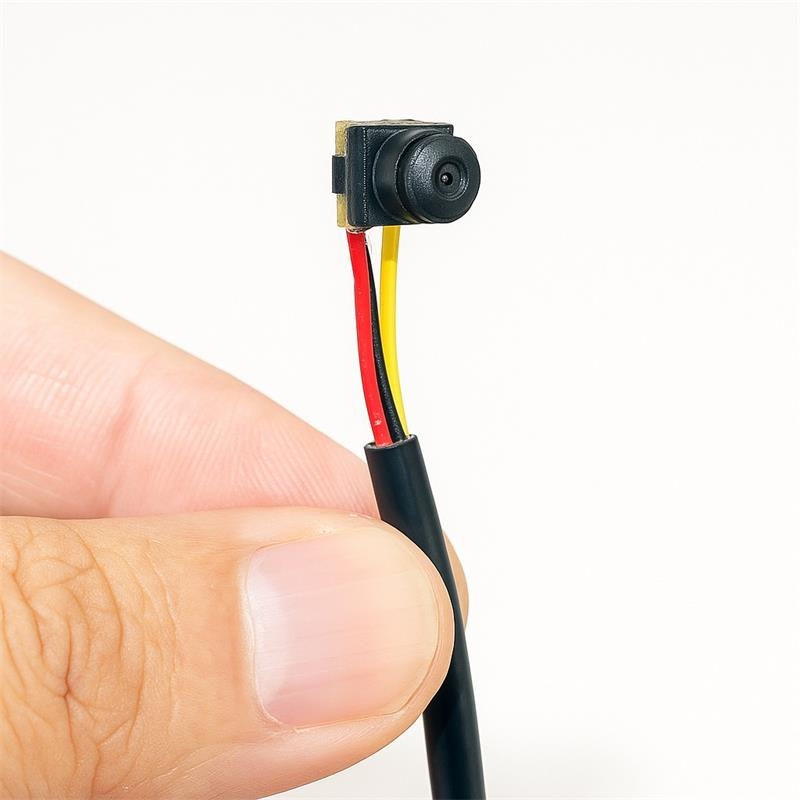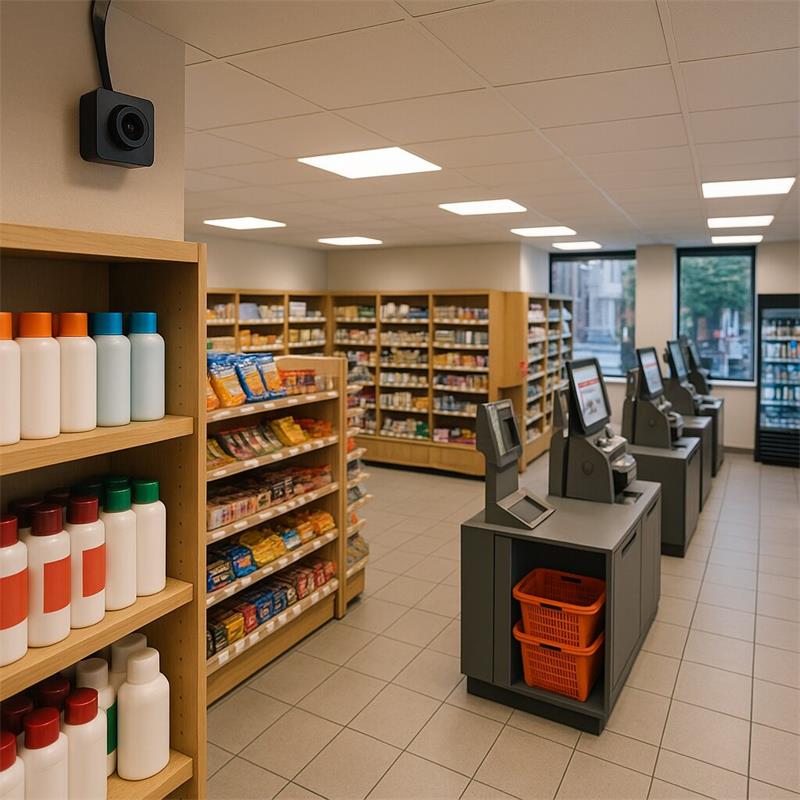
London’s multi-format retail—convenience, high-street fashion, chemists, and travel hubs—faces a dual constraint: tight spaces and dynamic lighting. Ceiling grids are crowded; gondolas and endcaps shift weekly; glass façades inject high contrast at entrances. A retail security camera that is both discreet and low-latency is essential for loss-prevention teams to gain actionable visibility without redesigning store interiors or adding network complexity.
This paper details how a 6×6 mm AHD wide-angle camera (720 P, 120° FOV) delivers coverage, stability, and fast deployment in London retail scenarios, and why analog HD over coax remains a pragmatic architecture for many chains upgrading legacy CCTV.
Typical constraints reported by London retailers and integrators:
Space & aesthetics: Traditional box domes can be conspicuous above POS, kiosks, or premium shelving. Many sites need a discreet security camera that can hide behind bezels or signage.
Mixed illumination: Doorways, atria, and shop windows produce high contrast; aisles alternate between warm and cool LED strips; reflection off glossy packaging challenges exposure.
Cabling reality: Numerous stores still have coaxial risers or mixed copper runs; pulling new Ethernet may be difficult due to heritage interiors and operating-hour limits.
Operator latency: For live intervention (floor-walker radio calls or security on-site), real-time video matters more than cloud analytics throughput.
The wish list is therefore consistent: micro-form-factor, wide FOV, long-distance video over coax, near-zero latency, and plug-and-play with existing DVRs.
Our 6×6 mm AHD Camera Module addresses these requirements directly:
Form factor: PCB footprint 6×6 mm, enabling concealed mounting in bezels, shelf edges, display headers, or kiosk panels.
Resolution & format: 720 P AHD output for stable, low-latency monitoring (PAL 25 fps by default; NTSC optional).
Optics: Stock 120° wide-angle lens; options from ~30°–120° to tune pixel density at target distance.
Transmission: 75 Ω coax for simple runs; typical 250 m reach with quality cable and proper terminations.
Latency: Analog HD path is essentially instantaneous—ideal for operator-driven observation and intercom/door-release workflows.
Power & environment: 12 V / ~50 mA camera draw; operating -10 °C to +60 °C for indoor retail environments.
Integration: Works with AHD DVRs and AHD monitors; can feed hybrid NVRs or AHD-to-IP encoders for VMS unification.
Cabling options: Standard lead ~0.5 m; configurable 20 cm–2 m harnesses to suit kiosk or fascia integration.
Note: Board-level module (non-waterproof). Use micro-enclosure if deployment near entryways or HVAC diffusers.
These properties allow the module to function as a retail security camera where conventional housings simply won’t fit, while preserving instantaneous operator feedback.

Coverage math for 120° FOV:
At a 2 m mount height, a 120° lens covers roughly a 3.5–4 m wide floor span at 2–3 m range, sufficient to capture POS lanes or two adjacent gondolas with one node. That reduces camera count, cabling trunks, and DVR channel usage.
Lens options:
90–100° for endcap focus (better pixel density on faces/hands).
120° for entrance and aisle junction monitoring.
30–60° for targeted views (cigarette gantry, locked cabinets).
Placement guidance:
Mount just ahead of the high-shrink SKU zone (health & beauty, spirits, razor blades).
Use angled brackets to avoid ceiling glare or LED reflections.
Maintain 1.8–2.4 m height for face and hand activity capture while minimizing occlusion.
Baseline (pure AHD):
Camera → Coax → AHD DVR → Local monitor + VMS gateway.
Pros: minimal configuration, inherent low latency, rapid rollout across many stores.
Hybrid (AHD to IP):
Camera → Coax → AHD encoder (H.264/H.265 IP) → NVR/VMS.
Pros: unify with corporate VMS/analytics, centralize retention.
Tip: keep AHD monitor near the kiosk or security station for real-time view; let the encoder supply the recording stream.
Power:
Shared 12 V rails are common in kiosks; add LC filters if sharing with card readers or thermal printers.
EMI hygiene:
Route coax away from POS PSU bricks and HVAC contactors; terminate correctly (75 Ω BNC). Use single-point grounding to avoid ground loops.
While IP cameras dominate analytics pipelines, 720 P AHD still excels where operator reaction time and fast retrofit matter:
Low-latency surveillance: Analog HD is essentially live, supporting door release, cash-handling supervision, and verbal interventions.
Cabling reuse: London stores frequently retain coax risers—AHD allows reuse without new cable pulls.
EMI resilience: Coax links are more tolerant near switch-mode PSUs, ticket barriers, or compact refrigeration.
Cost profile: Lower BOM at the edge; no switch provisioning or PoE budgeting; simpler maintenance.
For analytics, an AHD encoder bridges to IP/NVR, combining the best of both worlds.

Customer profile: An anonymized London convenience chain (10 pilot sites; mix of Zone 1–3).
Objective: Reduce theft at health & beauty and spirits aisles; ensure real-time visibility at self-checkout (SCO) clusters.
Deployment plan:
22 units/site average:
120° modules at three aisle junctions per store.
Narrow-FOV modules above razor/fragile goods.
One POS-facing module per SCO bank (two in larger sites).
Cabling: Retained legacy RG-59; new drops kept under 50 m; two runs per site extended to ~130 m with low-loss coax.
Head-end: Existing AHD DVR retained; two channels per site fed to a compact AHD-to-IP encoder for corporate VMS events.
Operator workflow:
Live AHD view at kiosk supervisor station → instant audio callouts via store radio.
Event clips ingested by VMS for regional review.
Observed outcomes (90-day pilot):
Fewer walk-outs at SCO during peak hours due to immediate verbal deterrence.
Improved evidence quality for targeted categories (hands-on-product visibility).
Reduction of blind spots at aisle junctions; staff reported better scene awareness.
Downtime < 0.5 % (mainly due to coax connectors; mitigated with crimp standardization).
Notes: Results are specific to this anonymized deployment and store mix. Performance depends on placement, illumination, and staff SOPs.
Exposure plan:
Fix shutter upper limit near 1/100–1/120 s to control LED flicker; use anti-flicker 50/60 Hz as needed.
Keep gain moderate; rely on lens FOV/placement to maintain target pixel density.
WDR/DWDR:
Backlit entrances benefit from mild WDR; avoid over-flattening which reduces textural cues on packaging.
DNR (2D/3D):
Moderate 2D + light 3D for aisles with motion; aggressive 3D DNR risks hand-motion smearing at SCO.
Sharpening:
Slight positive edge enhancement (+1) is sufficient; excessive sharpening amplifies barcode/label halos.
Thermal: The module’s power draw (~50 mA @ 12 V) is modest; passive airflow in ceiling voids suffices.
Mechanical: Use standoffs or a micro-enclosure; apply threadlocker on adjustable lens barrels to resist vibration.
Cleaning: Protect with a low-profile dust window; periodic microfiber wipe avoids soft haze over time.
Spares: Because the camera count per site is high, keep 5–10 % spare modules and pre-crimped coax tails for quick swap.
TCO takeaway: For stores with coax in place, the commercial surveillance module + AHD DVR approach minimizes CAPEX and project duration while preserving operator immediacy.
Signage: Maintain clear CCTV signage at entrances; align with company privacy policy.
Masking: Configure privacy masks where needed (staff areas, sensitive desks).
Retention: Coordinate DVR retention with corporate policies and local guidance.
Data path: Live AHD view is local; only encoded IP streams traverse the network to VMS—helpful for segmenting risk.
(This is engineering guidance, not legal counsel.)
retail security camera, AHD wide-angle camera, commercial surveillance module
discreet security camera, embedded CCTV, low-latency surveillance, analog HD over coax
long-distance video over coax, loss-prevention technology, POS surveillance, store theft reduction
These terms reflect active interest in retrofit-friendly and operator-centric solutions in retail security.
For London’s dense, design-sensitive retail floors, the 6×6 mm AHD wide-angle camera provides coverage where full-size housings cannot go, latency where IP cannot match, and speed-to-deploy where budgets and operating hours are tight. Pair it with existing AHD DVRs or hybrid encoders and you gain a scalable, low-risk path to better real-time visibility across entrances, aisles, and self-checkout zones.
Looking to modernize embedded CCTV without ripping and replacing cabling?
Explore our commercial surveillance module portfolio
Request a store-layout review and lens/FOV plan
Ask for a pilot bundle: camera modules, micro-enclosures, and AHD-to-IP encoders
Let’s turn your legacy coax into a high-impact, low-latency retail security solution—built for London, ready for scale.